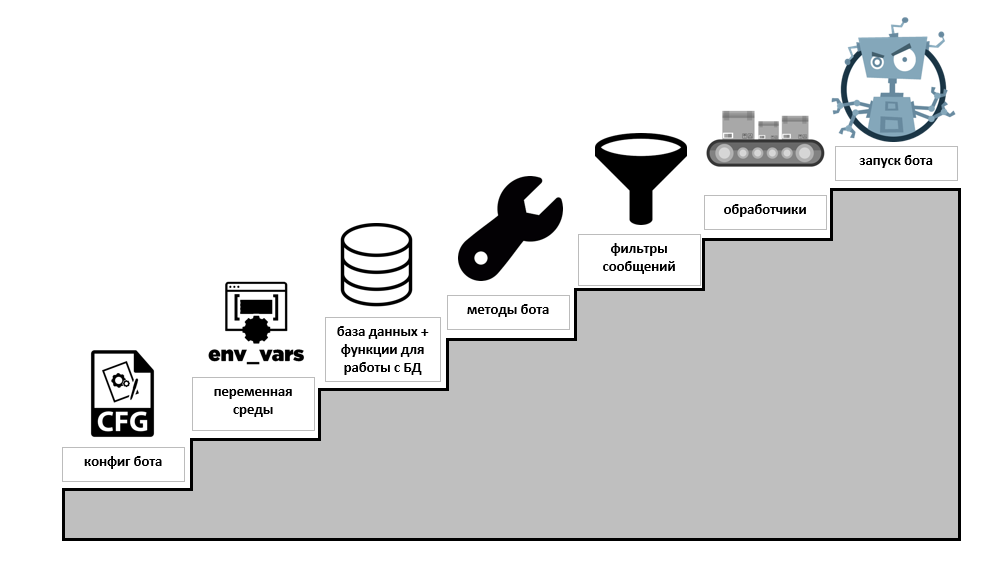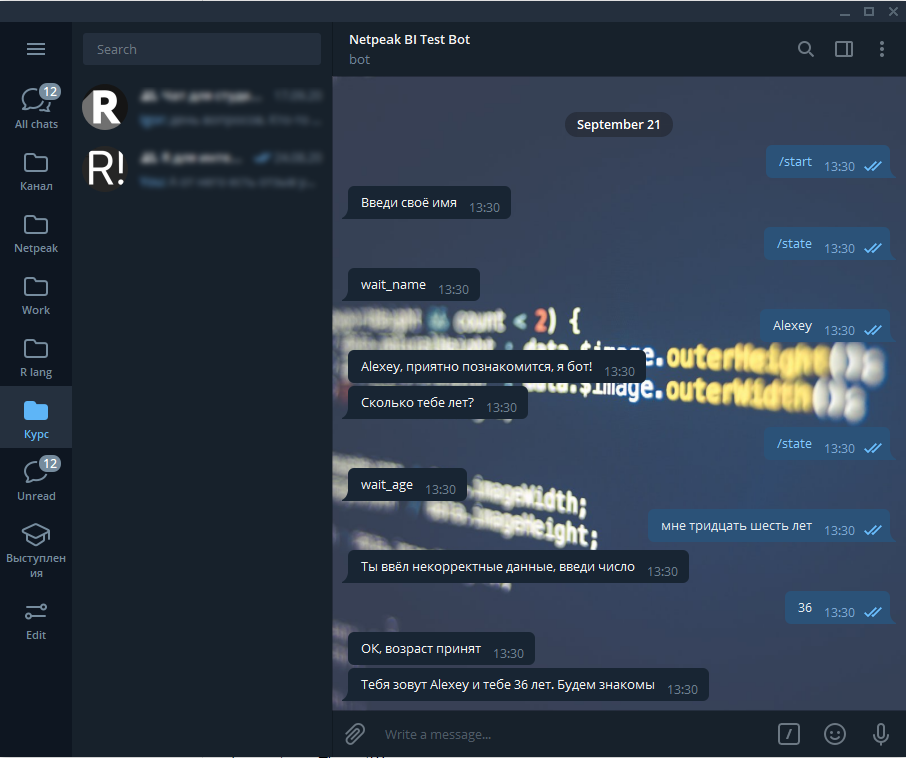如果您已经阅读了本系列的前三篇文章,那么您已经知道如何使用键盘编写完整的电报机器人。
在本文中,我们将学习如何编写能够保持一致对话的机器人。那些。机器人会问您问题并等待您输入任何信息。机器人将根据您输入的数据执行一些操作。
同样在本文中,我们将学习如何在机器人的控制下使用数据库,在我们的示例中将是SQLite,但是您可以使用任何其他DBMS。我更详细地写在R语言数据库交互这篇文章。

该系列的所有文章“用R语言编写电报机器人”
- 我们创建一个机器人并使用它发送消息到电报
- 向机器人添加命令支持和消息过滤器
- 如何为您的机器人增加键盘支持
- 与机器人建立一致,逻辑的对话
- Bot用户权限管理
内容
telegram youtube . R.
, , - . , , SQLite.
.. . , - , , .
, , , . , , .
:
- start — ,
- wait_name — ,
- wait_age — , , .
, :

- , . , .
- , .
- , , .
- , .. .
- . , .
- , .
- .
, .
- bot.R —
- db_bot_function.R —
- bot_methods.R —
- message_filters.R —
- handlers.R —
- config.cfg —
- create_db_data.sql — SQL
- create_db_state.sql — SQL
- bot.db —
, GitHub.
ini , :
[bot_settings]
bot_token=__
[db_settings]
db_path=C://///bot.db, , .. bot.db, .
, ini , JSON.
, , TG_BOT_PATH.
, — .Renviron.
, file.edit(path.expand(file.path("~", ".Renviron"))). :
TG_BOT_PATH=C:////.Renviron RStudio.
— . 2 :
- chat_data —
- chat_state —
SQL :
CREATE TABLE chat_data (
chat_id BIGINT PRIMARY KEY
UNIQUE,
name TEXT,
age INTEGER
);
CREATE TABLE chat_state (
chat_id BIGINT PRIMARY KEY
UNIQUE,
state TEXT
);
GitHub, R.
#
library(DBI) #
library(configr) #
library(readr) # SQL
library(RSQLite) # SQLite
#
setwd(Sys.getenv('TG_BOT_PATH'))
#
cfg <- read.config('config.cfg')
# SQLite
con <- dbConnect(SQLite(), cfg$db_settings$db_path)
#
dbExecute(con, statement = read_file('create_db_data.sql'))
dbExecute(con, statement = read_file('create_db_state.sql'))
. .
GitHub, db_bot_function.R.
# ###########################################################
# Function for work bot with database
#
get_state <- function(chat_id) {
con <- dbConnect(SQLite(), cfg$db_settings$db_path)
chat_state <- dbGetQuery(con, str_interp("SELECT state FROM chat_state WHERE chat_id == ${chat_id}"))$state
return(unlist(chat_state))
dbDisconnect(con)
}
#
set_state <- function(chat_id, state) {
con <- dbConnect(SQLite(), cfg$db_settings$db_path)
# upsert
dbExecute(con,
str_interp("
INSERT INTO chat_state (chat_id, state)
VALUES(${chat_id}, '${state}')
ON CONFLICT(chat_id)
DO UPDATE SET state='${state}';
")
)
dbDisconnect(con)
}
#
set_chat_data <- function(chat_id, field, value) {
con <- dbConnect(SQLite(), cfg$db_settings$db_path)
# upsert
dbExecute(con,
str_interp("
INSERT INTO chat_data (chat_id, ${field})
VALUES(${chat_id}, '${value}')
ON CONFLICT(chat_id)
DO UPDATE SET ${field}='${value}';
")
)
dbDisconnect(con)
}
# read chat data
get_chat_data <- function(chat_id, field) {
con <- dbConnect(SQLite(), cfg$db_settings$db_path)
# upsert
data <- dbGetQuery(con,
str_interp("
SELECT ${field}
FROM chat_data
WHERE chat_id = ${chat_id};
")
)
dbDisconnect(con)
return(data[[field]])
}4 :
get_state()—set_state()—get_chat_data()—set_chat_data()—
, dbGetQuery(), UPSERT ( ), dbExecute().
UPSERT :
INSERT INTO chat_data (chat_id, ${field})
VALUES(${chat_id}, '${value}')
ON CONFLICT(chat_id)
DO UPDATE SET ${field}='${value}';.. chat_id . , , .
.
. GitHub, bot_methods.R.
# ###########################################################
# bot methods
# start dialog
start <- function(bot, update) {
#
# Send query
bot$sendMessage(update$message$chat_id,
text = " ")
#
set_state(chat_id = update$message$chat_id, state = 'wait_name')
}
# get current chat state
state <- function(bot, update) {
chat_state <- get_state(update$message$chat_id)
# Send state
bot$sendMessage(update$message$chat_id,
text = unlist(chat_state))
}
# reset dialog state
reset <- function(bot, update) {
set_state(chat_id = update$message$chat_id, state = 'start')
}
# enter username
enter_name <- function(bot, update) {
uname <- update$message$text
# Send message with name
bot$sendMessage(update$message$chat_id,
text = paste0(uname, ", , !"))
#
#username <<- uname
set_chat_data(update$message$chat_id, 'name', uname)
#
bot$sendMessage(update$message$chat_id,
text = " ?")
#
set_state(chat_id = update$message$chat_id, state = 'wait_age')
}
# enter user age
enter_age <- function(bot, update) {
uage <- as.numeric(update$message$text)
#
if ( is.na(uage) ) {
#
bot$sendMessage(update$message$chat_id,
text = " , ")
} else {
#
bot$sendMessage(update$message$chat_id,
text = ", ")
#
#userage <<- uage
set_chat_data(update$message$chat_id, 'age', uage)
#
username <- get_chat_data(update$message$chat_id, 'name')
userage <- get_chat_data(update$message$chat_id, 'age')
bot$sendMessage(update$message$chat_id,
text = paste0(" ", username, " ", userage, " . "))
#
set_state(chat_id = update$message$chat_id, state = 'start')
}
}5 :
- start —
- state —
- reset —
- enter_name —
- enter_age —
start , wait_name, .. .
, enter_name, , , wait_age.
. , , - : , , . , , , , , .. start.
state , reset .
. , .
GitHub message_filters.R.
:
# ###########################################################
# message state filters
#
MessageFilters$wait_name <- BaseFilter(function(message) {
get_state( message$chat_id ) == "wait_name"
}
)
#
MessageFilters$wait_age <- BaseFilter(function(message) {
get_state( message$chat_id ) == "wait_age"
}
) get_state(), , . 1 , id .
wait_name wait_name, wait_age wait_age.
handlers.R, :
# ###########################################################
# handlers
# command handlers
start_h <- CommandHandler('start', start)
state_h <- CommandHandler('state', state)
reset_h <- CommandHandler('reset', reset)
# message handlers
## !MessageFilters$command - ,
##
wait_age_h <- MessageHandler(enter_age, MessageFilters$wait_age & !MessageFilters$command)
wait_name_h <- MessageHandler(enter_name, MessageFilters$wait_name & !MessageFilters$command), , , .
2 , !MessageFilters$command, , .
, bot.R.
library(telegram.bot)
library(tidyverse)
library(RSQLite)
library(DBI)
library(configr)
#
setwd(Sys.getenv('TG_BOT_PATH'))
#
cfg <- read.config('config.cfg')
#
updater <- Updater(cfg$bot_settings$bot_token)
#
source('db_bot_function.R') #
source('bot_methods.R') #
source('message_filters.R') #
source('handlers.R') #
#
updater <- updater +
start_h +
wait_age_h +
wait_name_h +
state_h +
reset_h
#
updater$start_polling() , :

/state , /reset .
, .
在这种情况下,我们考虑了最原始的示例,以使您更容易理解构建此类机器人的想法,实际上您可以构建更复杂的对话。
在本系列的下一篇文章中,我们将学习如何限制bot用户使用各种方法的权利。